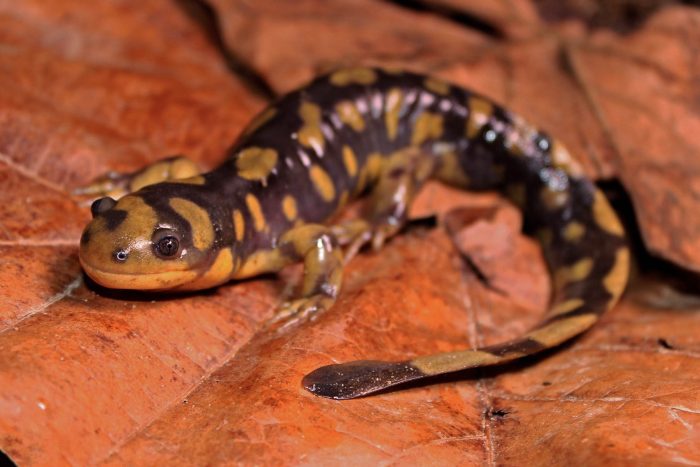Eastern Tiger Salamander
Ambystoma tigrinum
The eastern tiger salamander is the largest land dwelling salamander in North America. It is found across the United States, but is an endagndered species in Delaware, Maryland and Virginia.
This section shows one large critter image at a time. Use the thumbnails that follow to select a specific image to display here.

This gallery contains a grid of small thumbnails. Selecting a thumbnail will change the main image in the preceding section.
Appearance
Eastern tiger salamanders have thick bodies with yellow blotches covering their dark brown or black skin. The spots have no set size or pattern, and can vary throughout their expansive range. Their bellies are yellowish or olive green. Their heads are large with a broad, rounded snout.
Eastern tiger salamanders generally grow to be between 7 and 8.5 inches in length, but can reach up to 13 inches. Males are generally longer, with a more compressed tail and stockier back legs. Larvae have a yellowish-green or olive body with dark blotches. They have a stripe along each side and a whitish underside.
Feeding
Diet includes worms, snails, insects, frogs and slugs.
Predators
Predators include badgers, snakes, bobcats and owls. Larvae are eaten by aquatic insects, other salamander larvae and snakes.
Reproduction and life cycle
Eastern tiger salamanders move to their breeding ponds in late winter or early spring. After courtship, females will lay eggs and attach them with twigs, grass stems and leaves to the bottom of the pond. An egg mass can contain up to 100 eggs.
Eggs can take anywhere between 19 and 50 days to hatch. After hatching, the larvae remain in the pond until they are adults, at 2.5 to five months old. Eastern tiger salamanders live up to 16 years in the wild.
Did you know?
- The eastern tiger salamander is the largest land dwelling salamander in North America.
- Eastern tiger salamanders spend most of their lives in underground burrows, which helps them escape extreme temperatures above.
- Overall, the eastern tiger salamander population is stable. However, their populations are declining in many areas—particularly in the southeast—due to lose of forest and wetland habitats.
- Eastern tiger salamanders are listed as endangered in Delaware, Maryland and Virginia.
- The largest recorded eastern tiger salamander was 13 inches in length.
Sources and additional information
- AmphibiaWeb – University of California
- Animal Diversity Web – University of Michigan Museum of Zoology
- Eastern Tiger Salamander – Virginia Herpetological Society
- Tiger Salamander – National Geographic
